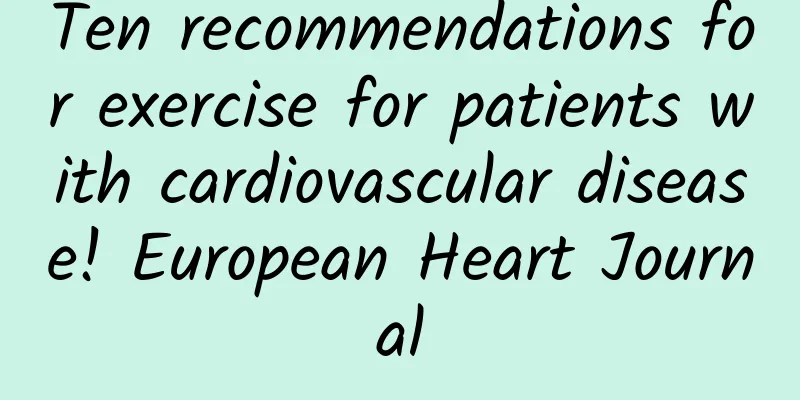Ten recommendations for exercise for patients with cardiovascular disease! European Heart Journal

|
Last August, the European Society of Cardiology (ESC) published its first-ever guidelines on exercise and physical activity for people with heart disease. For details, please see: The most comprehensive exercise advice! ESC releases cardiovascular disease and exercise guidelines Recently, the European Heart Journal summarized the guidelines and made the following "top ten recommendations": 1. All patients with cardiovascular disease should do their best to exercise for at least 150 minutes, 5 days a week, or 75 minutes of vigorous exercise, 3 days a week. 2. For people with obesity, hypertension or type 2 diabetes, it is recommended to perform an additional 20 minutes of strength training three times a week to reduce cardiovascular risk. 3. Preliminary identification of high-risk groups for atherosclerotic coronary artery disease through symptom assessment, identified risk factors, and systematic coronary risk evaluation (SCORE). 4. People at high risk of adverse cardiac events caused by atherosclerotic coronary artery disease should undergo risk stratification through exercise stress testing or functional imaging if they want to engage in high-intensity exercise. 5. Before prescribing exercise for patients with heart failure, it is essential to optimize medical therapy, assess function, and risk stratify. 6. Regular physical exercise is the cornerstone of preventing atrial fibrillation in the general population; however, lifelong endurance exercise may increase the risk of atrial fibrillation in some middle-aged and older men. 7. Asymptomatic patients with mild hypertrophic cardiomyopathy and a low 5-year risk score can participate in all competitive sports, except those in which syncope could result in potentially fatal trauma. 8. Patients with severe valvular heart disease, poor left ventricular function, arrhythmogenic cardiomyopathy and active myocarditis should not engage in high-intensity exercise. 9. Patients receiving anticoagulant therapy and with ICD implanted should avoid participating in activities that may cause potential trauma. 10. For individuals who are at risk for significant cardiovascular disease and wish to participate in high-intensity or competitive sports, shared decision-making is recommended to inform the individual of the effects of exercise and the potential risks of complications and/or adverse events. Source: Sharma S, Pelliccia A, GatiS. The 'Ten Commandments' for the 2020 ESC Guidelines on Sports Cardiology and Exercise in Patients with Cardiovascular Disease. Eur Heart J. 2021 Jan1;42(1):6-7. Reprinted from: China Circulation Magazine |
>>: "Don't wait for foreign countries to be immune, China will be in danger instead"
Recommend
When will Donnie Yen's "Enter the Fat Dragon" be released? Is "Enter the Fat Dragon" free to watch on iQiyi?
Due to the novel coronavirus, many movies have be...
"Eat for Health" Special Series | Feeling a little anxious? Why not eat something "sour"!
Do you feel anxious? Some young people often suff...
Sudden stomach pain during pregnancy
If you suddenly experience abdominal pain in the ...
Can I eat Torreya grandis during menstruation?
We may rarely eat Torreya grandis in our daily li...
What is the partition between the bedroom and the living room? How to partition the living room and the bedroom?
We all know that many apartment types are relativ...
What does RHD antigen positive mean?
Many people are worried about the positive result...
The road for foreign payment brands such as Apple Pay to enter China is destined to be a difficult one
199IT original compilation Recently, the US payme...
Can chronic cervicitis turn into cancer?
Female patients with chronic cervicitis are very ...
Is blood in leucorrhea after menstruation a serious gynecological disease?
It is actually not easy for female friends, so th...
This sweet potato-like fruit is the "king of oligofructose" and can improve blood lipids and enhance immunity! Try it now
Speaking of yacon, many people will think of the ...
Black blood clots during ovulation
What is the reason for black blood clots in ovula...
Can uterine ultrasound show inflammation?
The health of the uterus is extremely important f...
Uterine fibroids diet, do you know the correct way to eat?
If you unfortunately suffer from uterine fibroids...
Should I use a belly belt after giving birth?
In order to create a baby, the mother's abdom...
What to do if your breasts become lumpy after weaning
The weaning period is not only a huge test for th...









